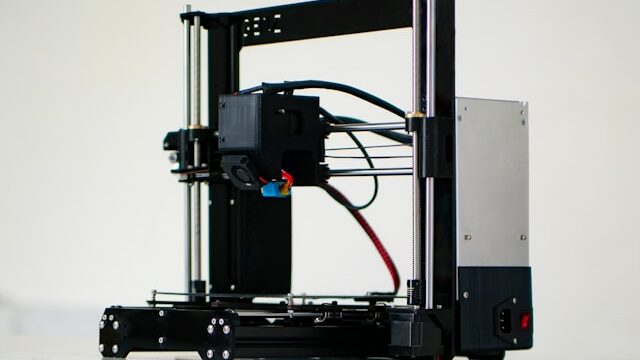Do you want to learn more about applications related to disability situations that can be achieved through 3D printing? At Imprimy, we are here to provide answers to all your questions.
3D printing supports people with disabilities by creating customized, affordable, and accessible assistive devices.

Can 3D printing be a tool to support disability?
Yes, 3D printing can support disability by producing personalized devices that improve mobility, communication, and independence.
- Can 3D printing be a tool to support disability?
- What are the practical applications of 3D printing for people with disabilities?
- What are the economic and social benefits of 3D printing for people with disabilities?
- What are the limitations of 3D printing for disabilities?
- Conclusion: 3D Printing and Disability
Reminder: the basics of 3D printing
3D printing is a process where a digital design is turned into a physical object by adding material layer by layer. It commonly uses plastics, resins, or metals to create items of almost any shape.
This technology allows for rapid prototyping and customization at a relatively low cost. Because of this flexibility, it’s especially useful in creating assistive devices tailored to individual needs.
3D printing to support people with disabilities
3D printing can create customized assistive devices, such as prosthetic limbs, wheelchair attachments or adaptive grips, at a lower cost than traditional methods. It allows for quick adjustments so each device fits the user’s specific needs.
This technology also enables faster production and replacement of parts. As a result, it increases accessibility and independence for people with disabilities.
What are the practical applications of 3D printing for people with disabilities?
Practical applications include custom prosthetics, orthotics, mobility aids, communication devices, and adaptive tools tailored to individual needs.
The creation of custom prosthetics and orthotics using 3D printing
3D printing allows prosthetics and orthotics to be tailored precisely to an individual’s body measurements. This customization improves comfort, function, and appearance compared to standard devices.
It also reduces production time and costs, making these devices more accessible. Additionally, designs can be quickly updated or replaced as a person’s needs change.
3D printed mobility and autonomy aids
3D printing can produce customized mobility aids like cane grips or ergonomic handles. These aids can be designed to match a user’s specific physical requirements, improving comfort and usability.
The technology also enables rapid prototyping and low-cost production, making it easier to test and refine designs.
3D printed communication accessories and devices
3D printing can create custom communication tools such as tablet mounts, switch holders or tactile symbols for people with speech or motor difficulties. These devices can be tailored to fit specific assistive technologies or user needs.
What are the economic and social benefits of 3D printing for people with disabilities?
3D printing reduces costs for personalized devices and increases accessibility, while enhancing independence, social participation, and overall quality of life.
The reduction of manufacturing costs through 3D printing
3D printing reduces manufacturing costs by using only the material needed to build an object layer by layer, minimizing waste. It eliminates the need for expensive molds or tooling, which is common in traditional manufacturing.Production can also happen locally, lowering shipping and storage expenses. This makes custom or small-batch items, like assistive devices, much more affordable.
Mass customization enabled by 3D printing
3D printing enables mass customization by allowing each product to be individually tailored without slowing production. Designs can be easily modified digitally to meet the specific needs of different users.
This is especially valuable for assistive devices, prosthetics, and orthotics. It combines the efficiency of mass production with the personalization of bespoke solutions.
Autonomy and quality of life improved through 3D printing
3D printing improves autonomy and quality of life by providing personalized assistive devices that fit users’ unique needs. Custom prosthetics, mobility aids, and communication tools enhance independence and daily functionality.
Faster, affordable production allows users to quickly replace or update devices as needed. Overall, it empowers people with disabilities to participate more fully in everyday activities.
What are the limitations of 3D printing for disabilities?
Limitations include material strength, printer precision, production speed, high costs, and limited access to technology and technical expertise.
The technological limitations of 3D printing applied to disability
3D printing for disability applications can be limited by the strength and durability of available materials, which may not withstand long-term or heavy use.
The precision of some 3D printers may restrict the complexity of functional designs. Production speed can also be slow for larger or detailed devices. Additionally, high-quality printers and materials can still be costly, limiting accessibility for some users.
The difficulties in accessing 3D printing technology
Accessing 3D printing technology can be challenging due to the high cost of professional-grade printers and specialized materials. Technical skills are often required to design and operate 3D printing equipment effectively.
Limited availability of local printing services can restrict access, especially in remote areas. These barriers can make it difficult for people with disabilities to benefit from customized devices.
The ethical and regulatory issues raised by 3D printing
3D printing raises ethical and regulatory issues because devices like prosthetics or medical aids must meet safety and quality standards. There is a risk of untested or poorly designed devices causing harm.
Intellectual property concerns also arise when reproducing patented designs. Regulators must balance innovation and accessibility with user safety and legal compliance.
Conclusion: 3D Printing and Disability
3D printing offers transformative opportunities for people with disabilities by enabling customized, affordable and rapidly produced assistive devices. It enhances autonomy, mobility, communication, and overall quality of life.
However, challenges such as technological limitations, access barriers and ethical or regulatory concerns must be addressed. With continued innovation and oversight, 3D printing has the potential to make disability support more inclusive and personalized.
Picture by Freepik.
The articles published on Imprimy.com are for informational purposes only. They are intended to provide general advice and information related to 3D printing. Imprimy.com cannot be held responsible for the results obtained or the consequences arising from the application of the shared information. We recommend always checking the specific instructions for your hardware and materials before use.


